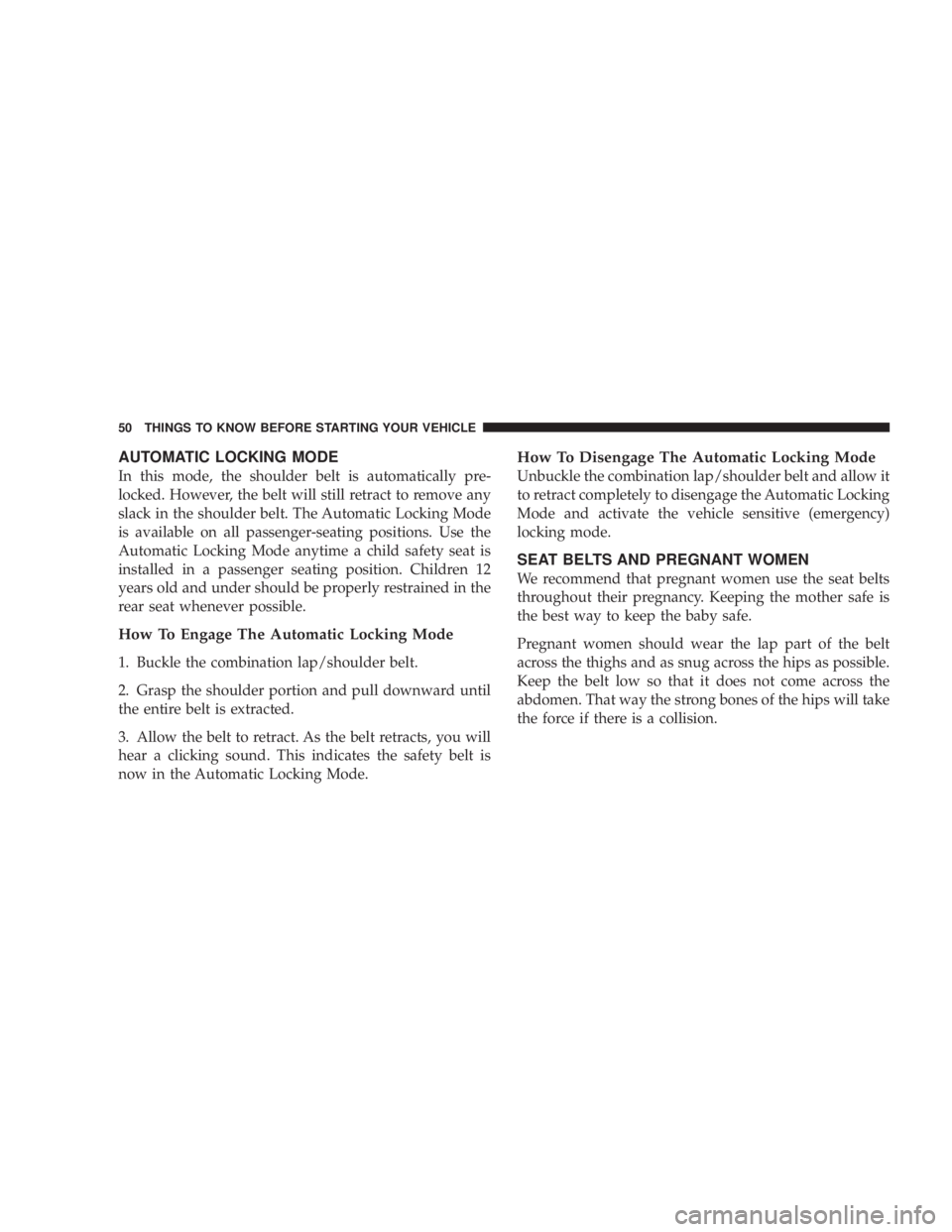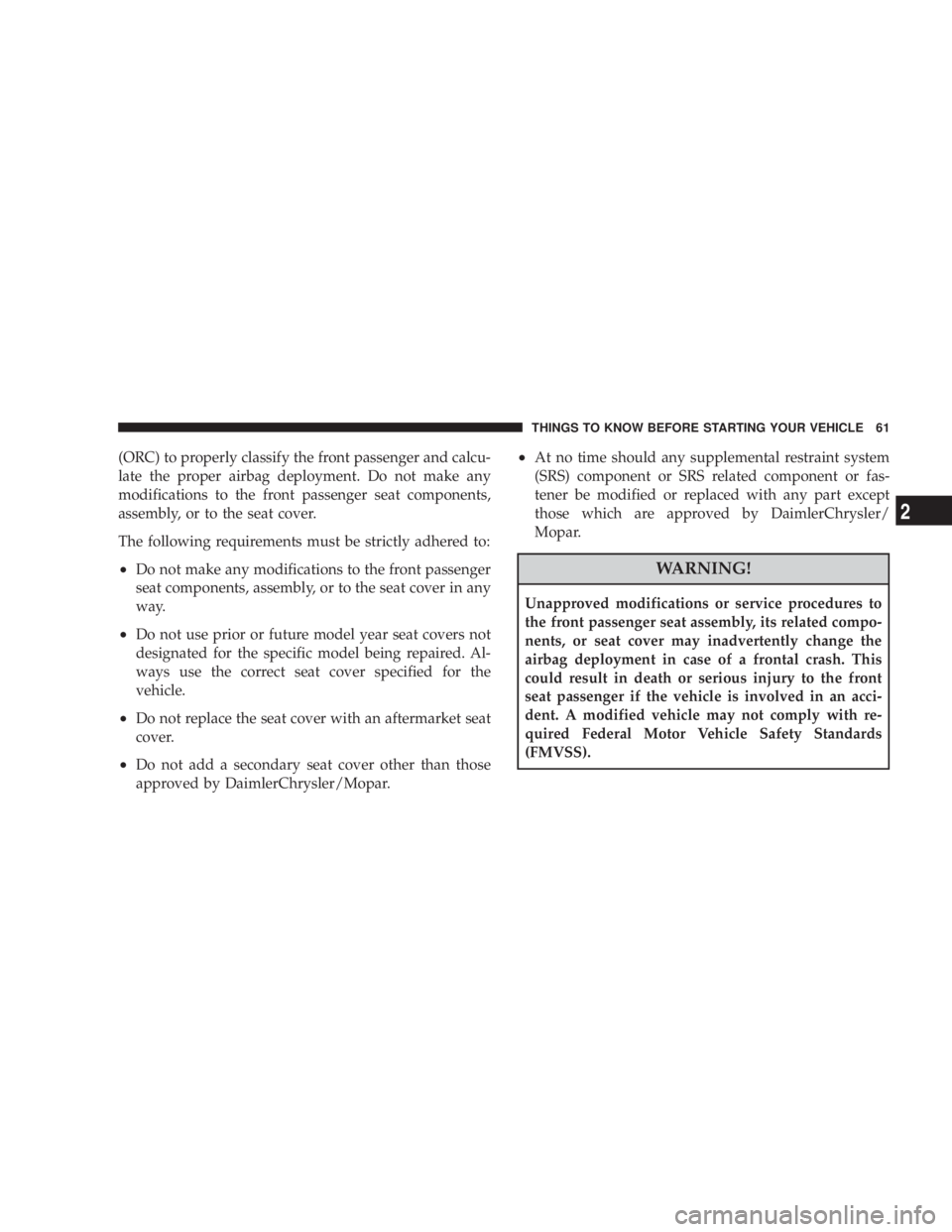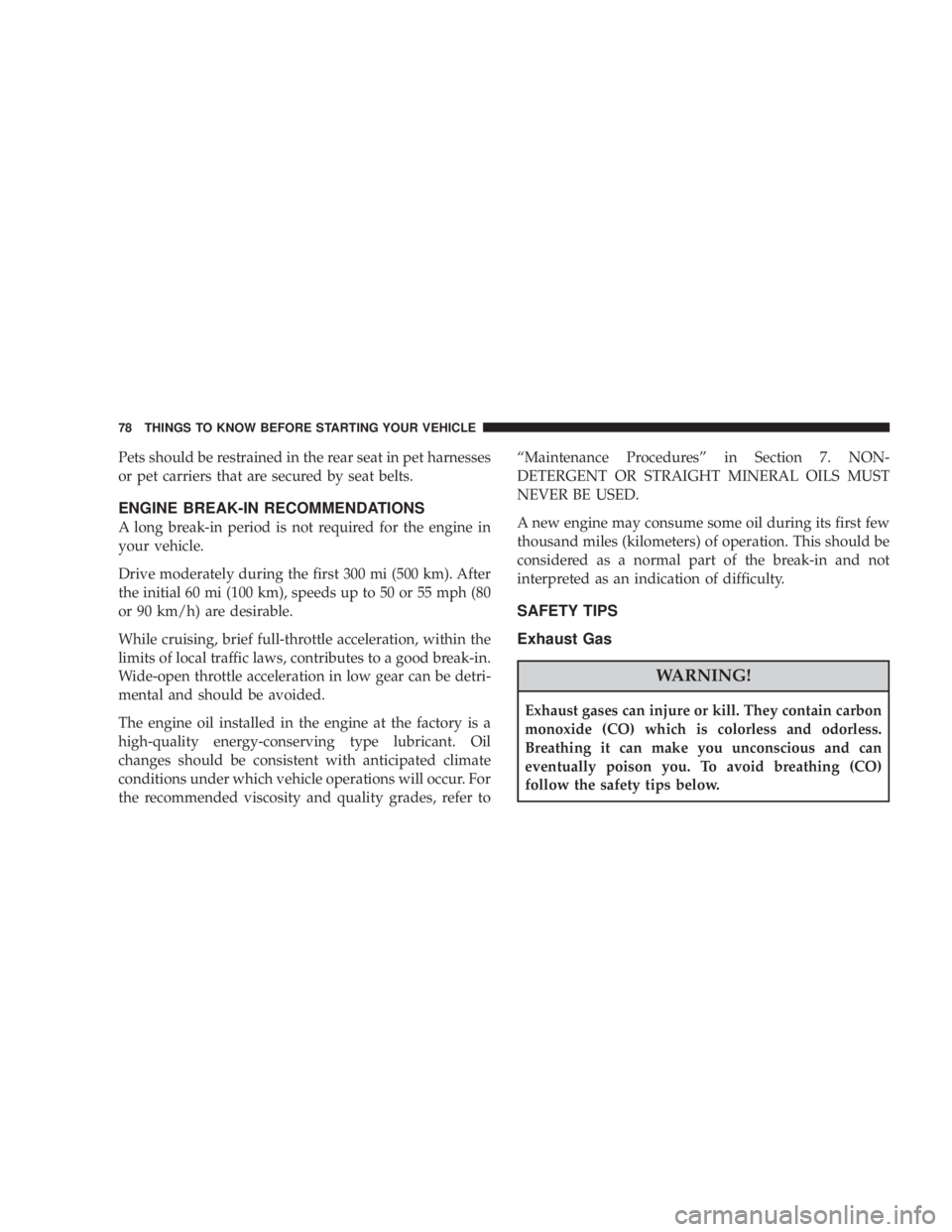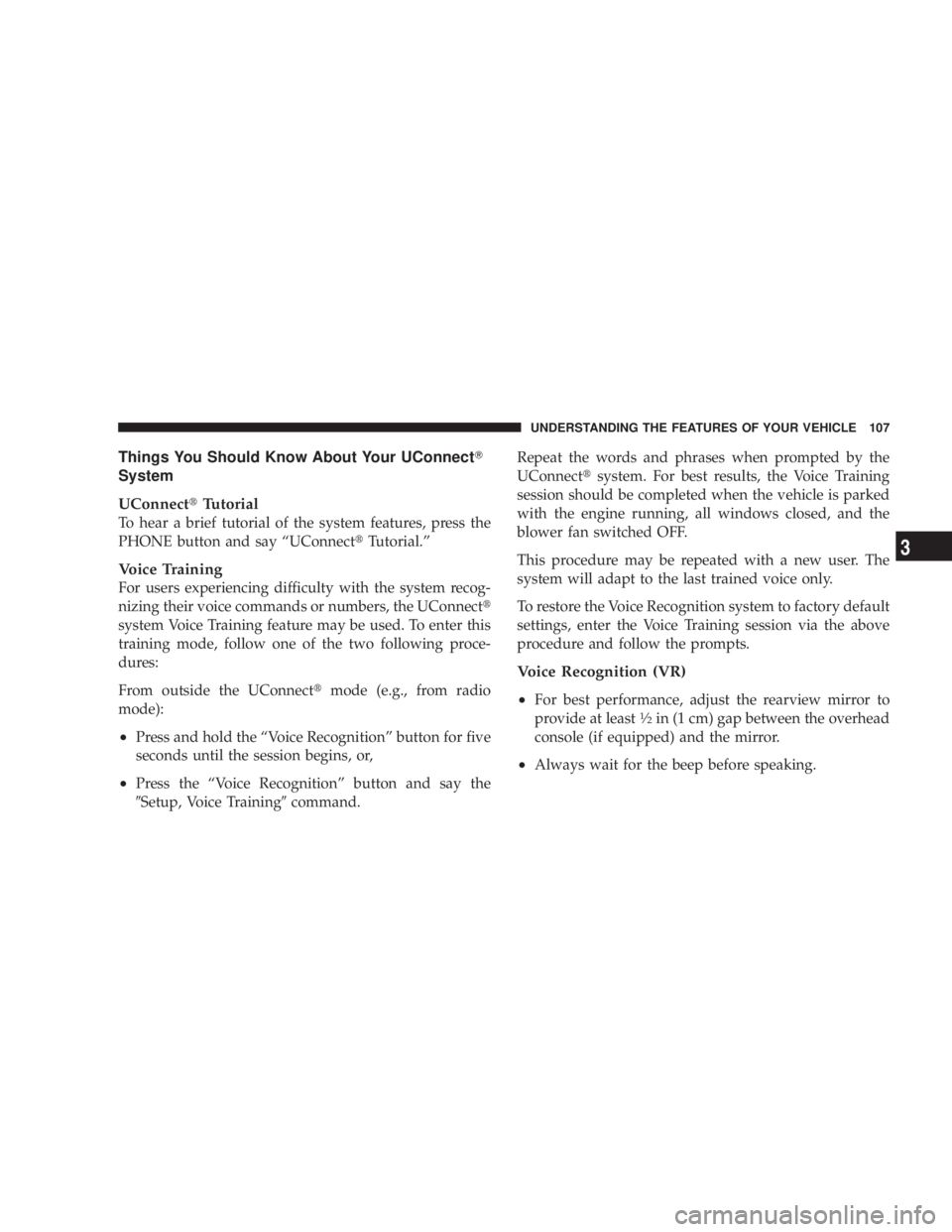Page 13 of 467
N Seat Belt Pretensioners ...................48
N Enhanced Seat Belt Reminder System
(BeltAlert t ) ..........................48
N BeltAlert t Programming .................49
N Automatic Locking Mode ................50
N Seat Belts And Pregnant Women ............50
N Supplemental Restraint System (SRS) - Airbag . .51
N Airbag System Components ...............52
N Front Seat Airbag Features ................53
N Airbag Deployment Sensors And Controls .....59 N Event Data Recorder (EDR) ...............65
N Child Restraint ........................67
m Engine Break-In Recommendations ...........78
m Safety Tips ............................78
N Exhaust Gas ..........................78
N Safety Checks You Should Make Inside The
Vehicle ..............................79
N Periodic Safety Checks You Should Make
Outside The Vehicle ....................80THINGS TO KNOW BEFORE STARTING YOUR VEHICLE 11
2
Page 32 of 467

To Exit Remote Start Mode And Drive The Vehicle
Before the end of the 15-minute cycle, press and release
the UNLOCK button on the RKE transmitter to unlock
the doors and disarm the Vehicle Security Alarm (if
equipped). Then, within 15 minutes, insert the key into
the ignition switch and turn the switch to the ON
position.
NOTE: The ignition switch must be in the ON position
in order to drive the vehicle.
To Turn Off The Engine While In Remote Start
Mode
Press and release the Remote Start button one time.
NOTE: To avoid inadvertent shut downs, the system
will disable the one-time press of the Remote Start button
for two seconds after receiving a valid remote start
request. DOOR LOCKS
MANUAL DOOR LOCKS
Use the manual door lock plunger to lock the doors from
inside the vehicle. If the plunger is down when the door
is closed, the door will lock. Therefore, make sure the
keys are not inside the vehicle before closing the door.
Manual Lock Plunger30 THINGS TO KNOW BEFORE STARTING YOUR VEHICLE
Page 52 of 467

AUTOMATIC LOCKING MODE
In this mode, the shoulder belt is automatically pre-
locked. However, the belt will still retract to remove any
slack in the shoulder belt. The Automatic Locking Mode
is available on all passenger-seating positions. Use the
Automatic Locking Mode anytime a child safety seat is
installed in a passenger seating position. Children 12
years old and under should be properly restrained in the
rear seat whenever possible.
How To Engage The Automatic Locking Mode
1. Buckle the combination lap/shoulder belt.
2. Grasp the shoulder portion and pull downward until
the entire belt is extracted.
3. Allow the belt to retract. As the belt retracts, you will
hear a clicking sound. This indicates the safety belt is
now in the Automatic Locking Mode. How To Disengage The Automatic Locking Mode
Unbuckle the combination lap/shoulder belt and allow it
to retract completely to disengage the Automatic Locking
Mode and activate the vehicle sensitive (emergency)
locking mode.
SEAT BELTS AND PREGNANT WOMEN
We recommend that pregnant women use the seat belts
throughout their pregnancy. Keeping the mother safe is
the best way to keep the baby safe.
Pregnant women should wear the lap part of the belt
across the thighs and as snug across the hips as possible.
Keep the belt low so that it does not come across the
abdomen. That way the strong bones of the hips will take
the force if there is a collision.50 THINGS TO KNOW BEFORE STARTING YOUR VEHICLE
Page 63 of 467

(ORC) to properly classify the front passenger and calcu-
late the proper airbag deployment. Do not make any
modifications to the front passenger seat components,
assembly, or to the seat cover.
The following requirements must be strictly adhered to:
² Do not make any modifications to the front passenger
seat components, assembly, or to the seat cover in any
way.
² Do not use prior or future model year seat covers not
designated for the specific model being repaired. Al-
ways use the correct seat cover specified for the
vehicle.
² Do not replace the seat cover with an aftermarket seat
cover.
² Do not add a secondary seat cover other than those
approved by DaimlerChrysler/Mopar. ² At no time should any supplemental restraint system
(SRS) component or SRS related component or fas-
tener be modified or replaced with any part except
those which are approved by DaimlerChrysler/
Mopar.
WARNING!Unapproved modifications or service procedures to
the front passenger seat assembly, its related compo-
nents, or seat cover may inadvertently change the
airbag deployment in case of a frontal crash. This
could result in death or serious injury to the front
seat passenger if the vehicle is involved in an acci-
dent. A modified vehicle may not comply with re-
quired Federal Motor Vehicle Safety Standards
(FMVSS). THINGS TO KNOW BEFORE STARTING YOUR VEHICLE 61
2
Page 80 of 467

Pets should be restrained in the rear seat in pet harnesses
or pet carriers that are secured by seat belts.
ENGINE BREAK-IN RECOMMENDATIONS
A long break-in period is not required for the engine in
your vehicle.
Drive moderately during the first 300 mi (500 km). After
the initial 60 mi (100 km), speeds up to 50 or 55 mph (80
or 90 km/h) are desirable.
While cruising, brief full-throttle acceleration, within the
limits of local traffic laws, contributes to a good break-in.
Wide-open throttle acceleration in low gear can be detri-
mental and should be avoided.
The engine oil installed in the engine at the factory is a
high-quality energy-conserving type lubricant. Oil
changes should be consistent with anticipated climate
conditions under which vehicle operations will occur. For
the recommended viscosity and quality grades, refer to ªMaintenance Proceduresº in Section 7. NON-
DETERGENT OR STRAIGHT MINERAL OILS MUST
NEVER BE USED.
A new engine may consume some oil during its first few
thousand miles (kilometers) of operation. This should be
considered as a normal part of the break-in and not
interpreted as an indication of difficulty.
SAFETY TIPS
Exhaust Gas
WARNING!Exhaust gases can injure or kill. They contain carbon
monoxide (CO) which is colorless and odorless.
Breathing it can make you unconscious and can
eventually poison you. To avoid breathing (CO)
follow the safety tips below.78 THINGS TO KNOW BEFORE STARTING YOUR VEHICLE
Page 81 of 467

Do not run the engine in a closed garage or in confined
areas any longer than needed to move your vehicle in or
out of the area.
If it is necessary to sit in a parked vehicle with the engine
running, adjust your heating or cooling controls to force
outside air into the vehicle. Set the blower at high speed.
WARNING!If you are required to drive with the deck lid open,
make sure that all windows are closed, and the
climate control blower switch is set at high speed.
DO NOT use the recirculation mode. Safety Checks You Should Make Inside The
Vehicle
Seat Belts
Inspect the belt system periodically, checking for cuts,
frays and loose parts. Damaged parts must be replaced
immediately. Do not disassemble or modify the system.
Front seat belt assemblies must be replaced after a
collision. Rear seat belt assemblies must be replaced after
a collision if they have been damaged (bent retractor, torn
webbing, etc.). If there is any question regarding belt or
retractor condition, replace the belt.
Airbag Light
The light should come on and remain on for six to eight
seconds as a bulb check when the ignition switch is first
turned ON. If the LED is not lit during starting, have it
checked. If the light stays on or comes on while driving,
have the system checked by an authorized dealer. THINGS TO KNOW BEFORE STARTING YOUR VEHICLE 79
2
Page 109 of 467

Things You Should Know About Your UConnect T
System
UConnect t Tutorial
To hear a brief tutorial of the system features, press the
PHONE button and say ªUConnect t Tutorial.º
Voice Training
For users experiencing difficulty with the system recog-
nizing their voice commands or numbers, the UConnect t
system Voice Training feature may be used. To enter this
training mode, follow one of the two following proce-
dures:
From outside the UConnect t mode (e.g., from radio
mode):
² Press and hold the ªVoice Recognitionº button for five
seconds until the session begins, or,
² Press the ªVoice Recognitionº button and say the
9 Setup, Voice Training 9 command. Repeat the words and phrases when prompted by the
UConnect t system. For best results, the Voice Training
session should be completed when the vehicle is parked
with the engine running, all windows closed, and the
blower fan switched OFF.
This procedure may be repeated with a new user. The
system will adapt to the last trained voice only.
To restore the Voice Recognition system to factory default
settings, enter the Voice Training session via the above
procedure and follow the prompts.
Voice Recognition (VR)
² For best performance, adjust the rearview mirror to
provide at least 1
¤ 2
in (1 cm) gap between the overhead
console (if equipped) and the mirror.
² Always wait for the beep before speaking. UNDERSTANDING THE FEATURES OF YOUR VEHICLE 107
3
Page 111 of 467

² In a convertible vehicle, system performance may be
compromised with the convertible top down.
Far End Audio Performance
² Audio quality is maximized under:
² low-to-medium blower setting,
² low-to-medium vehicle speed,
² low road noise,
² smooth road surface,
² fully closed windows,
² dry weather conditions, and
² operation from the driver's seat.
² Performance, such as audio clarity, echo, and loudness
to a large degree rely on the phone and network, and
not the UConnect t system. ² Echo at the far end can sometimes be reduced by
lowering the in-vehicle audio volume.
² In a convertible vehicle, system performance may be
compromised with the convertible top down.
Bluetooth t Communication Link
Cellular phones have been found to lose connection to
the UConnect t system. When this happens, the connec-
tion can generally be re-established by switching the
phone off/on. Your cell phone is recommended to remain
in Bluetooth t ON mode.
Power-Up
After switching the ignition key from OFF to either ON
or ACC position, or after a language change, you must
wait at least five seconds prior to using the system. UNDERSTANDING THE FEATURES OF YOUR VEHICLE 109
3